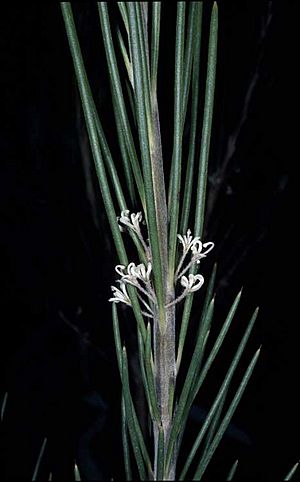Hakea macrorrhyncha facts for kids
Quick facts for kids Hakea macrorrhyncha |
|
|---|---|
 |
|
| Hakea macrorrhyncha flowers in the Australian National Botanic Gardens | |
| Conservation status | |
|
Rare (NCA)
|
|
| Scientific classification | |
| Genus: |
Hakea
|
| Species: |
macrorrhyncha
|
 |
|
| Occurrence data from AVH | |
Hakea macrorrhyncha is a special shrub or small tree. It belongs to the Proteaceae plant family. This plant is native to Australia, meaning it naturally grows there. You can find it in specific areas of north-eastern New South Wales and south-eastern Queensland. It's considered a rare species, which means it's not found everywhere.
Contents
What Does Hakea macrorrhyncha Look Like?
This plant can grow as a tall shrub or a small tree. It usually has one main stem or splits into two close to the ground. It can reach a height of about 1.8 to 6 metres (6 to 20 feet). Its young branches are covered with soft, matted hairs. These hairs stay on the branches until the plant flowers.
Leaves and Flowers
The leaves of Hakea macrorrhyncha are like needles. They are often grooved underneath. Each leaf is about 4.5 to 9 centimetres (1.8 to 3.5 inches) long. They are also very thin, about 0.9 to 1.5 millimetres wide. When they first appear, the leaves look white. They are covered with thick, matted hairs. As they get older, they become smooth and lose their hairs.
The flowers grow in groups of 3 to 4. They appear where the leaves join the stem. This spot is called a leaf axil. The main stalk of the flower group is rounded. It is about 0.5 to 0.7 millimetres long. This stalk is covered with white, woolly hairs. Each individual white flower has its own stalk. These stalks are about 4 to 5.5 millimetres long. They have a moderate amount of soft, matted hairs.
The flower parts that protect the bud are called sepals and petals. They are short and cream-white in colour. They measure about 3 to 3.8 millimetres long. They are covered with soft, white hairs. The style is a part of the flower that helps with reproduction. It is about 6.5 to 8 millimetres long and curves backwards.
Fruit
After flowering, the plant produces fruit. The fruit is shaped like a broad egg. It is about 35 to 45 millimetres (1.4 to 1.8 inches) long. It can be 21 to 30 millimetres wide. The surface of the fruit has a network of wrinkled lines. It also has small, blister-like bumps. The fruit tapers into a long, triangular "beak." The cream-white flowers usually appear from August to September.
How Was Hakea macrorrhyncha Named?
The scientific name for this plant, Hakea macrorrhyncha, was first officially described in 1996. This was done by a scientist named William Barker. His description was published in the Journal of the Adelaide Botanic Garden.
The second part of the name, macrorrhyncha, is called the specific epithet. This part comes from the Greek words macro- and rhynch-.
- Macro- means "long."
- Rhynch- means "nose" or "beak."
This name refers to the long, beak-like shape of the fruit.
Where Does Hakea macrorrhyncha Grow?
Hakea macrorrhyncha is found in specific areas. It grows around the Torrington area in north-eastern New South Wales. You can also find it in the nearby Girraween National Park and its surrounding areas. It is also present in south-eastern Queensland.
This plant prefers to grow in hilly areas. These areas often have granite rocks. It grows in open forests or low woodlands. This means the trees are not too dense, allowing some sunlight to reach the ground.
Why Is Hakea macrorrhyncha Important?
Hakea macrorrhyncha is classified as a rare species. This classification is under Queensland's Nature Conservation (Wildlife) Regulation 2006. Being rare means there are not many of these plants left in the wild. This makes it important to protect them so they don't disappear. Conservation efforts help ensure these unique plants continue to thrive in their natural habitats.

